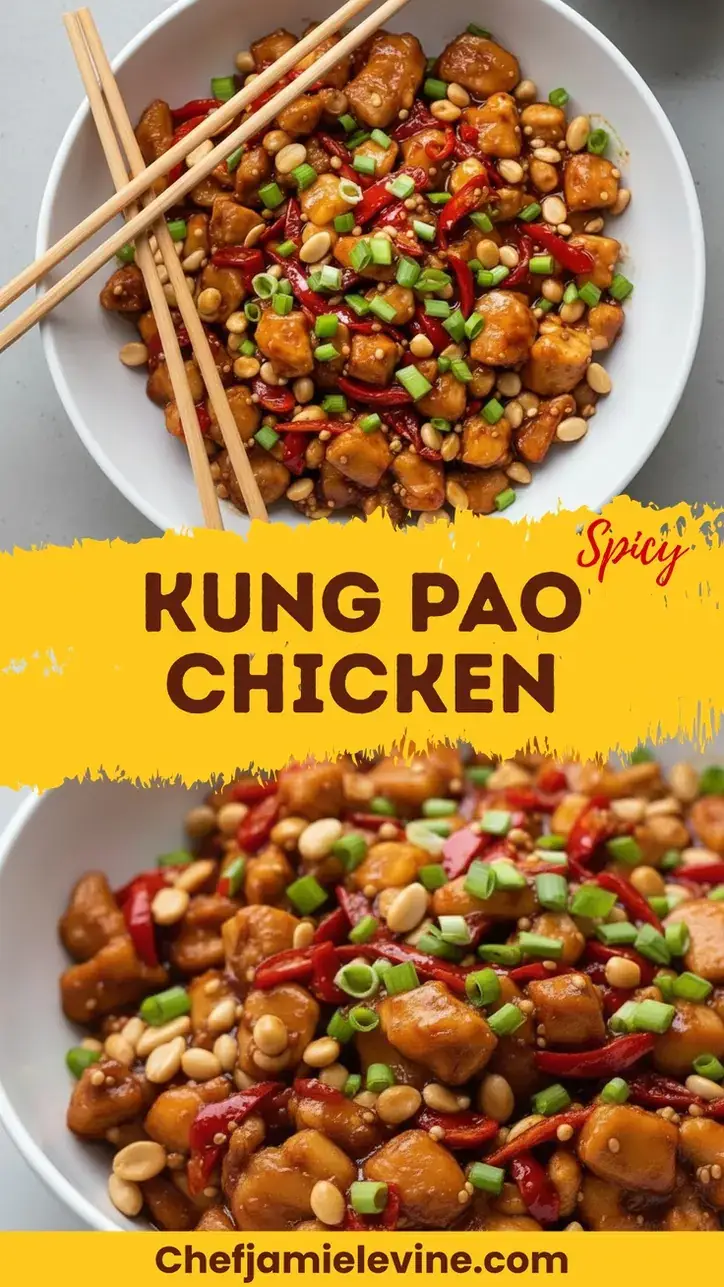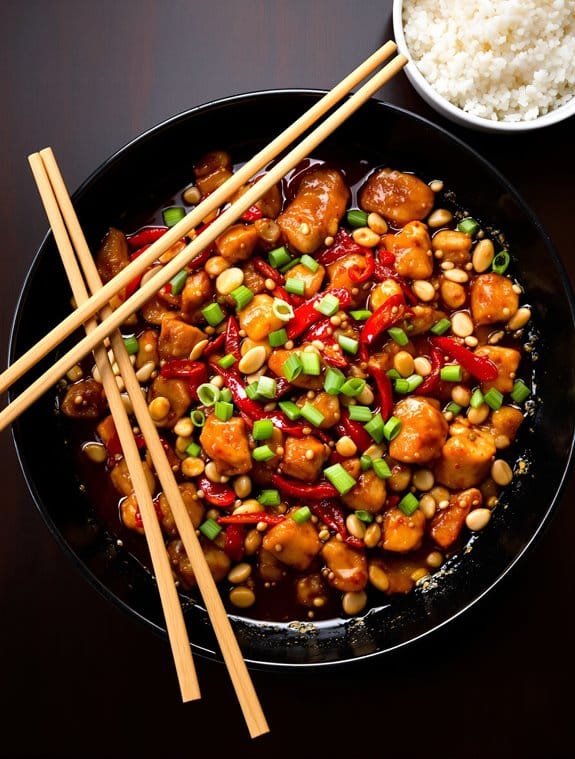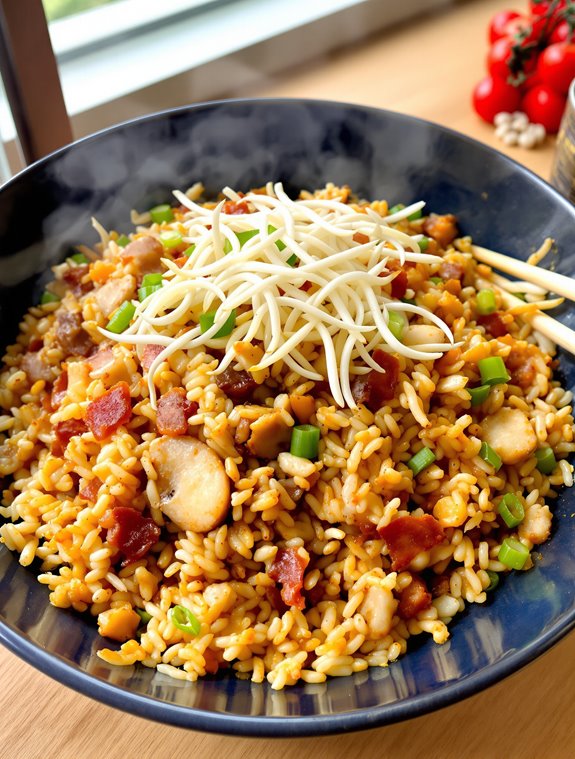Why You’ll Love this Authentic Kung Pao Chicken
Every authentic Kung Pao Chicken recipe should transport you straight to Sichuan with that perfect balance of spicy, sweet, sour, and savory flavors—and this one delivers. I’ve tested dozens of versions, and this one hits all the right notes without requiring obscure ingredients.
You’ll love how the dried chilies infuse the oil with their distinctive heat while the Szechuan sauce adds that numbing quality that makes your taste buds dance. The chicken stays tender, the bell peppers add crunch, and those savory bites deliver restaurant-quality results in your kitchen. Need a dinner that impresses? This is it.
What Ingredients are in Authentic Kung Pao Chicken?
To create authentic Kung Pao Chicken, you’ll need a combination of pantry staples and a few specialty Asian ingredients that provide that distinctive Sichuan flavor profile.
The beauty of this dish lies in its balance of heat, sweetness, and that characteristic numbing sensation that makes Kung Pao so craveable. Once you gather these ingredients, you’re just minutes away from a restaurant-quality meal that will make takeout seem completely unnecessary.
- 4 boneless skinless chicken breasts
- 5 tablespoons soy sauce
- 2 teaspoons sugar
- 4 Asian dried red chilies, split
- ½ tablespoon grated ginger
- 1 pinch red pepper flakes
- 1½ tablespoons canned Szechuan sauce
- 2 tablespoons sherry wine
- 2 teaspoons sesame oil
- 2 tablespoons rice vinegar
- ¼ cup water
- 1 tablespoon minced garlic
- 2 tablespoons peanut oil (or other light oil)
- 1 red bell pepper, cut into chunks
- 2 teaspoons cornstarch
While traditional Kung Pao Chicken would include Sichuan peppercorns for that numbing sensation, this recipe simplifies things by using canned Szechuan sauce which contains those flavors.
If you want to amp up the authenticity, you might consider adding a teaspoon of ground Sichuan peppercorns if you can find them.
And though not listed, many cooks like to garnish with roasted peanuts or cashews for that traditional crunch.
Remember that the dried chilies are primarily for flavoring the oil—you can adjust the quantity based on your heat preference without compromising the dish’s soul.
How to Make this Authentic Kung Pao Chicken

Creating authentic Kung Pao Chicken at home starts with proper preparation. Begin by cutting your 4 boneless skinless chicken breasts into bite-sized cubes – not too small or they’ll overcook, but not so large that they won’t cook through quickly. Toss these chicken pieces with 1 tablespoon of soy sauce and 1 tablespoon of sherry wine, then set them aside to marinate while you prepare the sauce. This brief marination makes all the difference, infusing the meat with flavor before it even hits the wok.
Next, whisk together your sauce components in a small bowl – 2 teaspoons of sugar, 2 tablespoons of rice vinegar, 2 teaspoons of sesame oil, ¼ cup of water, the remaining 4 tablespoons of soy sauce, 1 tablespoon of sherry, and 2 teaspoons of cornstarch. This slurry will thicken beautifully when it hits the hot wok.
Now for the cooking! Heat 2 tablespoons of peanut oil in your wok over medium-high heat until it shimmers. Add those 4 split dried Asian red chilies and cook until they darken slightly – this infuses the oil with spicy goodness without making the dish overwhelmingly hot. Can you smell that amazing aroma developing?
Add 1 tablespoon of minced garlic, ½ tablespoon of grated ginger, and a pinch of red pepper flakes, stirring constantly for about 30 seconds until fragrant. The kitchen should be filling with that intoxicating ginger-garlic perfume that signals good things are happening.
Now add your marinated chicken with its juices, stir-frying for 1-2 minutes until the outside changes color. Pour in your sauce mixture along with the red bell pepper chunks, and continue cooking for just about a minute more until the chicken is cooked through and the sauce has thickened to a glossy finish.
For that authentic Sichuan kick, remove from heat and stir in 1-1½ tablespoons of canned Szechuan sauce. The transformation from simple ingredients to complex, layered flavors is nothing short of culinary magic.
Authentic Kung Pao Chicken Substitutions and Variations
While our classic recipe delivers that perfect balance of flavors, I understand not everyone has access to traditional Sichuan ingredients.
No Szechuan sauce? Try mixing hoisin with a bit of sriracha. The dried chilies can be replaced with red pepper flakes, though you’ll miss that distinctive numbing heat.
Vegetarians, sub in extra-firm tofu or tempeh—just press it well first. Don’t have peanut oil? Any neutral oil works fine.
Rice vinegar can be swapped for apple cider vinegar in a pinch. And if you’re watching carbs, cauliflower florets make a surprisingly good chicken alternative.
The flavor profile shifts slightly, but that addictive sweet-spicy-savory punch remains intact.
What to Serve with Authentic Kung Pao Chicken
Pairing sides with authentic Kung Pao Chicken can elevate your meal from merely delicious to absolutely memorable.
I always serve mine with steamed jasmine rice – its subtle fragrance perfectly balances the spicy kick of those dried chilies. Want something beyond basic rice? Try cooking some bok choy with garlic or serving cucumber salad dressed with rice vinegar for a cooling contrast.
Hot and sour soup makes a fantastic starter, while spring rolls provide that crispy texture complement.
For a complete feast, don’t forget scallion pancakes – they’re perfect for soaking up that savory Szechuan sauce. Trust me, your dinner guests will be asking for seconds.
Final Thoughts
Now that we’ve covered the accompaniments, I’d like to share some final reflections on this Kung Pao chicken journey.
This dish has become my go-to when I’m craving something with a perfect balance of heat, sweetness, and that satisfying crunch from the bell peppers.
The beauty of Kung Pao is in its adaptability—adjust the chilies to your heat preference, or swap chicken for tofu for a vegetarian version.
What I love most? The way those Szechuan flavors transform ordinary ingredients into something extraordinary.
Trust me, once you master this recipe, takeout will never quite satisfy you the same way again.

Kung Pao Chicken
Ingredients
Equipment
Method
- Toss the cubed chicken with 1 tablespoon of soy sauce and 1 tablespoon of sherry wine. Set aside to marinate while preparing the sauce.
- In a small bowl, whisk together 2 teaspoons sugar, 2 tablespoons rice vinegar, 2 teaspoons sesame oil, ¼ cup water, the remaining 4 tablespoons soy sauce, 1 tablespoon sherry, and 2 teaspoons cornstarch until well combined.
- Heat 2 tablespoons peanut oil in a wok over medium-high heat until shimmering. Add the split dried red chilies and cook until they slightly darken, about 30 seconds.
- Add minced garlic, grated ginger, and red pepper flakes. Stir constantly for about 30 seconds until fragrant.
- Add the marinated chicken with its juices and stir-fry for 1-2 minutes until the outside changes color.
- Pour in the sauce mixture along with the red bell pepper chunks. Continue cooking for about 1 minute more until the chicken is cooked through and the sauce has thickened to a glossy consistency.
- Remove from heat and stir in the Szechuan sauce. Mix well to incorporate the flavors throughout the dish.
- Serve immediately over steamed rice for an authentic Sichuan experience.



